Curators unveiled a portrait of Capt. George Vancouver on Tuesday, opening old mysteries about a painting that has sat in the archives of the Royal B.C. Museum for more than 100 years.
The painting was presented publicly in small ceremony near the museum’s replica of HMS Discovery, the ship Vancouver used to explore and map the B.C. coast in the late 18th century.
The portrait, a reproduction of one in the British National Portrait Gallery, was donated to the museum by William Walter in 1901 and has resided in the museum archives ever since.
But according to the museum’s curator of history, it’s not entirely certain who painted the original, who painted the reproduction and why it was donated to the museum.
“It’s a portrait of mystery,” Lorne Hammond said.
Vancouver served with Capt. James Cook on two voyages between 1772 and 1778. In 1791, Vancouver, now in command of HMS Discovery, returned to map the northwest coast of North America. At more than 4 1/2 years, it was the longest surveying expedition in history.
Vancouver received little recognition for his exploits, however. Upon his return to England, Hammond said, he became embroiled in controversy, denounced as the cruellest captain in the Royal Navy.
A sailor with political connections even attacked Vancouver in the street with his cane, an incident immortalized in a political cartoon of the time.
“So he is pushed aside and put on a half-pension,” Hammond said.
Vancouver spent the remainder of his days writing a three-volume history of his exploration. He died within 100 pages of its completion; the books were finished by his brother. It’s during this time that artist Lemuel Abbott, famed for portraits of George Washington and Vice-Admiral Horatio Nelson, is said to have been commissioned to paint Vancouver.
But, Hammond said, Abbott found himself on the outs with English society and was committed to an asylum.
It’s now questioned whether Abbott actually painted the Vancouver portrait — and whether it’s of George Vancouver or the brother who finished his books.
Since the painting and its copy are the only known portraits of Vancouver, the identification remains unconfirmed.
Hammond said it’s not clear how a copy of the portrait made its way to Victoria. Archivists at the museum and the legislature are now looking to learn more.
But there are still other questions to be answered, Hammond said — especially about reactions of First Nations peoples not just to historical encounters with people like Vancouver but to modern encounters with place names written over their own.
“What does it mean in a post-colonial truth and reconciliation world?” he said. “What we want to do is have a dialogue in our galleries.”
The painting was revealed in a small ceremony attended by Janice Charette, Canada’s high commissioner to the U.K., who cited the long historical connection between Britain and Canada, including the more than 100 places along the coast named for and by Vancouver.
“There is a lot of ties between his work and in the Royal Navy and who we are today as a country,” Charette said.



